Table of Contents
Designing Packaging for Shelf-Ready Displays
In the competitive retail landscape, packaging serves as more than just protection for products. It functions as a crucial marketing tool that can significantly impact consumer purchasing decisions. Shelf-ready packaging (SRP) specifically addresses the challenges of retail visibility, offering solutions that streamline stocking while maximizing visual impact at the point of sale.
Fundamentals of Shelf-Ready Packaging
Shelf-ready packaging refers to product packaging designed to transition easily from shipping to retail display with minimal handling. Effective SRP serves dual purposes: it protects products during transit and transforms into an attractive display unit once in store. According to research on shelf appeal in big box stores, packages that require less than five seconds of handling time for retail staff can increase product placement efficiency by up to 40%.
The core elements of successful shelf-ready packaging include:
- Easy identification for warehouse staff
- Simple opening mechanisms for retail employees
- Stability when displayed on shelves
- Effective product presentation to consumers
- Minimal waste generation after deployment
Visual Hierarchy and Brand Recognition
Creating visual hierarchy within packaging design ensures that consumers notice key elements in a specific order. As highlighted in this guide on packaging as a silent salesperson, effective shelf-ready displays guide the eye from brand identification to product benefits and finally to purchase information.
Color Psychology in Retail Displays
Color selection dramatically influences consumer perception and can increase brand recognition by up to 80%. For cannabis products specifically, our humidity control packaging solutions demonstrate how even functional elements can incorporate strategic color usage to stand out while maintaining product freshness, an essential consideration for flower products.
Material Selection for Maximum Impact
Material choices significantly impact both the functional and aesthetic aspects of shelf-ready packaging. Premium finishes like soft-touch coatings can increase perceived value, while structural integrity ensures products remain presentable throughout their shelf life.
According to experts in retail packaging design, materials that offer tactile differentiation can increase consumer interaction by up to 30%, leading to higher conversion rates. This is particularly relevant in specialty retail where consumers often make decisions based on physical interaction with packaging.
Structural Design Considerations
The physical structure of shelf-ready packaging must balance several competing priorities:
Stability and Stackability
Packages must remain upright and stable on shelves while maximizing vertical space utilization. Interlocking designs or flat tops can facilitate stacking, increasing product density without sacrificing visibility.
Accessibility and Product Removal
Consumers should be able to access products easily without damaging the display. Perforations, tear-away sections, and strategically placed openings can facilitate this while maintaining structural integrity.
Modularity for Different Retail Environments
Adaptable designs that work across various retail settings maximize distribution potential. As noted in this analysis of club store packaging, modular designs that can function in both warehouse and boutique environments provide significant competitive advantages.
Retail Environment Adaptation
Different retail environments demand different packaging approaches. Mass merchandisers, specialty shops, and convenience stores each present unique challenges and opportunities for shelf-ready packaging.
Seasonal Considerations
Temporary displays for seasonal promotions require special attention to quick assembly and visual impact. Holiday-themed packaging strategies can increase seasonal sales by up to 30% when properly executed with shelf-ready displays that highlight limited-time offerings.
Lighting Interaction
Store lighting significantly affects how packaging appears on shelves. Materials that interact positively with store lighting, such as selective gloss finishes or holographic elements, can draw attention even in poorly lit areas. Testing packaging under various lighting conditions ensures consistent visual appeal across different retail environments.
As research on packaging conversion rates indicates, packages designed with store lighting considerations show up to 25% higher consumer engagement rates.
Implementation Strategies for Brand Success
Successfully implementing shelf-ready packaging requires collaboration between design, manufacturing, and retail partners. Brands that excel in this area typically follow these best practices:
- Conduct in-store testing before full deployment
- Gather feedback from retail staff about ease of use
- Monitor consumer interaction patterns
- Continuously refine designs based on real-world performance
- Develop packaging systems rather than isolated solutions
The most successful brands view shelf-ready packaging as an ongoing process rather than a one-time design challenge. By monitoring performance metrics and adapting to changing retail environments, these brands maintain their competitive edge through packaging innovation.
When developing your next packaging solution, remember that effective shelf-ready displays don't just hold products, they actively sell them through strategic design choices that enhance visibility, communicate brand values, and facilitate positive consumer interactions.











Leave a comment
All comments are moderated before being published.
This site is protected by hCaptcha and the hCaptcha Privacy Policy and Terms of Service apply.